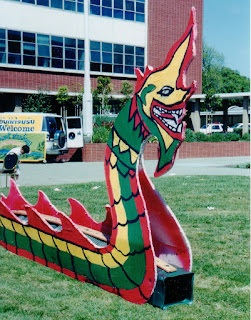There is one special group of immigrants that I want to talk about here, and that is refugees.
Refugees are immigrants who arrived in the United States under especially difficult circumstances. For the most part, they are people fleeing war and for the most part, they will probably never be able to return to their native land. Many also spent months, or sometimes years, in refugee camps before settling in North America.
 |
| Dragon from Lao New Year's celebration, Richmond, CA. |
And many know almost nothing of life in the United States before their arrival. Government policy frequently directs that they be settled far apart from each other, I guess because someone in government thinks they will adopt the customs of this country faster that way.
If I had just had to flee my country due to war, possibly having seen neighbors and family members killed before I was able to get away, I'd be miserable if upon arrived, I also had to be separated from others who followed my customs and spoke my language, but no one in government asked me.
I've had the privilege of knowing quite a number of refugees, mostly from Southeast Asia and in particular, mostly from Laos. They fled their homes because of what is called in this country the Vietnam War, but which in some other places is called the Southeast Asia War, since it involved at least three different countries.
One of the refugees who really stands out in my mind is named Yang Xiong. Yang's language and ethnicity are Hmong. He is from Laos, and we were lucky enough to be able to film an interview with him called Roots and Branches: Yang Xiong.
Video clip from our interview with Yang Xiong in 2004.
Yang was about six years old when his family and everyone from his village had to pack up all their belongings and leave the country. They walked through the jungle by night to avoid being shot, carrying their belongings on their backs.
When they, and thousands of other people fleeing Laos, arrived at the Mekong River, they had to cross it in order to survive: the Mekong is the border between Laos and Thailand. There were, however, only rafts and flimsy boats to get them across. I heard from Yang and other Laotian refugees that many of the boats were overloaded with terrified people. And many of the overloaded boats overturned in the river. Most of these people didn't know how to swim, and so they drowned.
Yang and his family made it across, and were lucky enough to have to spend only a few months in refugee camps in Thailand before being accepted into the United States.
I don't have time to tell any more of his story here (you'll have to watch the video for that, or go to his Facebook page), but will just mention that as an adult, he spent many years working at a youth center in the San Francisco Bay Area that focused on helping the Southeast Asian youth...and their parents.
Now, he lives in the Central Vally, is married, and has recently become father to his sixth child.
 |
| Yang Xiong in 2012. |
If you want to find out more about the Hmong people in the United States, one source is LINK.
OUR NEXT POST will be about Thanks, MAW (Media Art Works) and a documentary about flamenco.

No comments:
Post a Comment